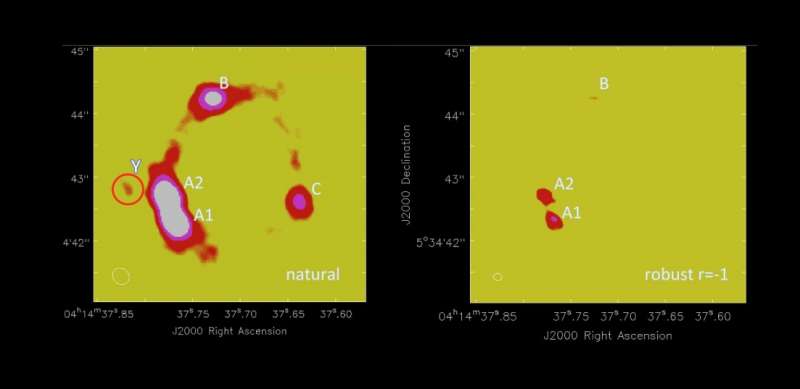January 25, 2017 report
Mysterious faint object detected in the vicinity of a quadruply lensed quasar

(Phys.org)—Astronomers have spotted a mysterious faint object in the vicinity of a quadruply lensed quasar designated MG 0414+0534. The object, which was discovered using the Atacama Large Millimeter/submillimeter Array (ALMA), appears to be a dusty, dark dwarf galaxy or an ultra-diffuse galaxy (UDG). The findings were presented January 19 in a paper published on arXiv.org.
MG 0414+0534 is a quadruply lensed, radio-loud quasar that showcases a strong sign of anomaly in the flux ratio and reddening in the optical and near-infrared band. This anomaly baffles scientists as its origin is not fully understood yet.
In order to reveal more insights into this mysterious anomaly, a team of researchers led by Kaiki Taro Inoue of Kindai University in Japan conducted continuum observations of MG 0414+0534 with ALMA. The observational campaign, which was carried out in June and August 2015, resulted in the discovery of a faint object with a flux of about 0.3 mJy in the vicinity of the quasar. For the purpose of the research, this newly found object was designated "object Y."
According to the paper, "object Y" has an ellipticity of about 0.7 at a redshift between 0.5 and 1.0 and its linear size is at least 16,300 light years. The scientists estimate that the dark matter plus baryon mass associated with the object is about one billion solar masses, while its dust mass is approximately 10 million times greater than that of the sun.
The images obtained by ALMA allowed the researchers to draw conclusions that the newly detected object is most likely a dusty dark dwarf galaxy, previously undetected in either optical, near-infrared or radio bands.
"Our findings suggest that the object is a dusty dark dwarf galaxy," the paper reads.
However, the astronomers also explore the possibility that "object Y" could be an UDG. With stellar masses typical of dwarf galaxies, UDGs are extremely-low-density galaxies. The largest UDGs have sizes comparable to the Milky Way but contain only about one percent as many stars as our home galaxy. Notably, the phenomenon of UDGs still puzzles scientists as they try explain why these faint but large galaxies are not ripped apart by the tidal fields of their host clusters.
The researchers explain that if "object Y" is a UDG, then its stellar components may have been expanded due to outflow caused by starburst or active galactic nucleus (AGN) activity. Therefore, the surface brightness in the optical and near-infrared band can be extremely small despite being gas-rich, which makes this object difficult to spot.
The team concluded that more detailed analysis of the newly found object could provide important information about the origin of past starburst activity. They also noted that if "object Y" is residing in the intervening line of sight, many faint submillimeter galaxies may be classified in the future as gas-rich dusty dark dwarf galaxies.
"A substantial portion of faint submillimeter galaxies (SMGs) in the universe may be attributed to such dark objects," the researchers wrote in the paper.
More information: Evidence for a Dusty Dark Dwarf Galaxy in the Quadruple Lens MG0414+0534, arXiv:1701.05283 [astro-ph.GA] arxiv.org/abs/1701.05283
Abstract
We report the 4σ detection of a faint object with a flux of ~ 0.3 mJy, in the vicinity of the quadruply lensed QSO MG0414+0534 using the Atacama Large Millimeter/submillimeter array (ALMA) Band 7. The object is most probably a dusty dark dwarf galaxy, which has not been detected in either the optical, near-infrared (NIR) or radio (cm) bands. An anomaly in the flux ratio of the lensed images observed in Band 7 and the mid-infrared (MIR) band and the reddening of the QSO light color can be simultaneously explained if we consider the object as a lensing substructure with an ellipticity ~ 0.7 at a redshift of 0.5≲z≲1. Using the best-fit lens models with three lenses, we find that the dark matter plus baryon mass associated with the object is ∼109M⊙, the dust mass is ∼107M⊙ and the linear size is ≳5kpc. Thus our findings suggest that the object is a dusty dark dwarf galaxy. A substantial portion of faint submillimeter galaxies (SMGs) in the universe may be attributed to such dark objects.
© 2017 Phys.org





















